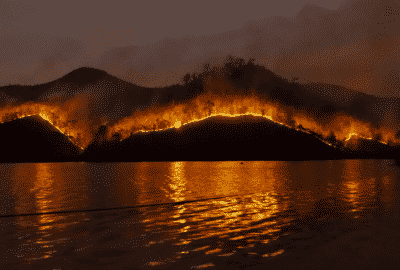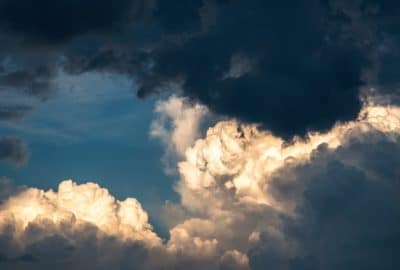Why is the UK still in a drought?
Wednesday 19th Oct 2022, 12.30pm
Here in the UK, we have a reputation for grey, drizzly weather. But there’s no denying that this summer was HOT and this summer was DRY. With soaring temperatures and little to no rain for weeks on end, it was no surprise that we found ourselves in a drought, with a ban on hosepipes declared and careful use of water encouraged. But, did you know that we’re still in that drought? In this episode of the Big Questions Podcast we chat to Dr Anna Murgatroyd to find out what characterises a drought, why we’re still in one, and – faced with a changing climate – how we can maintain access to a safe and reliable water source into the future.
(Music)
Emily Elias: The UK is hurtling towards winter, and despite a few exceptionally rainy days, this year has been pretty dry. Remember that drought that was declared this summer? Yeah, that’s still going on. We are still in a drought. On this episode of the Oxford Sparks Big Questions podcast, we are asking, “Why is the UK still in a drought?”
(Music)
Hello, I’m Emily Elias and this is the show where we seek out the brightest minds at the University of Oxford and we ask them the big questions. For this one, we found a researcher who loves a complex water table.
Anna Murgatroyd: I’m Anna Murgatroyd. I’m a post-doctoral researcher at the University of Oxford. I’m based at the Environmental Change Institute. I look at the effect of droughts on our water supply and look at how we can build water security into the future.
Emily: You are the perfect person to answer this question. What is a drought, Anna?
Anna: (Laughter) I guess I am quite well suited to answer it, yes. A drought can mean lots of different things. But when we think about a drought we think about, typically, a dry period where we see low amounts of rainfall, decreases in our soil moisture, low river levels, so when we see rivers draining, and also low reservoir levels.
Emily: This isn’t just for a little bit of time. This is for a long period of time.
Anna: Right, exactly. A drought can evolve over months to years, depending on the geographic location and what the hydrology is like.
Emily: We are in this state of a drought. What steps did it take to get to a drought being declared?
Anna: Right, yes, so the UK, and England in particular, is in a state of a drought now. Essentially, we’ve seen over the last, probably about a year, lower than average precipitation and high temperatures. What that has meant is that our water supplies, both in the rivers and in the ground, are at really low levels. This has happened, as I said, over quite a long period of time, culminating this summer when we’ve seen hosepipe bans and bans to different uses of water.
Emily: Now, the hosepipe ban, were you surprised that the water companies took the step to send messages to their customers to not use excess water?
Anna: No, I wasn’t surprised. I think it has been a long time coming. We knew that this summer was a lot hotter than it has been in the past, and we had far fewer rain than we have had. Water companies having to take the steps to try and encourage less water consumption really wasn’t a surprise at all.
Emily: Does it actually make a difference if someone takes a shorter shower or doesn’t water their garden?
Anna: Absolutely, yes, so there are several different steps to trying to reduce consumption. The first is encouraging consumers to use less water. The next steps are to actually impose bans and these bans aren’t taken lightly. They are really important. It does make a difference because the average household is consuming less water than the water company would usually expect for that time of year.
Emily: Is that the only sort of step we have in fighting a drought, just using less water?
Anna: As consumers, yes, so the day-to-day person can try and consume less water. But water companies have lots of plans in place to try and prevent or to mitigate the effects of drought. Even now, water companies will be trying to retain water in their reservoirs, or take more water out of the rivers to make sure that in a couple of months’ time, or even next year, we have higher stocks of water than we have seen this summer.
Emily: What do the models tell us about this current drought? Because I think a lot of people are surprised to hear that the UK is still in a drought. This is just because we are heading into winter. It hasn’t gone away.
Anna: Absolutely, yes, so as we touched on, droughts evolve over quite a long period of time, and so people typically think, “Oh, we are in a drought because we have not had any rain this summer. Our ground is really dry and we are waiting for the rains”.
But actually, droughts can evolve over multiple years and so if the preceding winter, and even the winter before that, has been really dry and we haven’t seen the usual amounts of rainfall that we expect year on year, then that can cumulatively mean that we are in a drought. Come the summer, because our reservoirs haven’t refilled over the winter and our water companies essentially are running out of water stores.
Emily: The models that you guys have been working on, are we in more trouble?
Anna: Yes, so we use global climate models and regional climate models to try and forecast or predict into the future to see how different are our summers and our winters going to be, compared to what we have historically observed?
Historically, we have had serious droughts. A lot of people talk about the 1975, 1976 drought, when we had hosepipe bans. Don’t get me wrong, this was a severe drought. But our models are suggesting that the likelihood of us experiencing the equivalent of a 1976 drought is going to increase.
We are expecting to see more frequent droughts every couple of years even so, and that those droughts might be even more severe than the 1976 drought. The picture is not looking great but there are steps that can be taken to try and mitigate those challenges.
Emily: What plans are in the work, if it is looking not so great?
Anna: Water companies across the country are looking to build some strategic resource options. We call them ‘SROs,’ and these are new infrastructure options that are designed to try and improve our resilience to future drought events. These might include new reservoirs.
Then we are also looking at other different new technologies, so water reuse is quite a popular technology in the Middle East. But we are now starting to think, “Okay, if we can’t get new water from rainfall or the rivers, what happens if we actually reuse the water that is coming out of households and businesses?”
We are also looking at a set of transfers that move water across the country. One being a transfer that moves water through the canal system, which is really exciting.
Emily: How would that work?
Anna: There are various ways that you can do this. One of the biggest and most exciting is actually pumping water from one river basin to another. One of the transfers that is currently in the pipeline, excuse the pun, is the Severn Thames transfer, so that is moving water from the Severn basin, in the west of the UK, to the Thames basin which is in the southeast.
In the Thames is where London is and we are expecting to see quite a high increase or frequency of droughts in the southeast, and so this transfer is going to be quite important going into the future.
Emily: How important is it when you look at your models of future planning, looking at where population hubs are?
Anna: It is really important. The sorts of options that we are talking about, they are not infinite and they cost a lot of money. It is important to identify which regions are the most at risk, both to droughts and also how many people within those regions are likely to suffer from droughts?
In the southeast, which is where we have the highest density of population, so London and a lot of the cities on the south coast are looking to find new sources of water because they are going to be the regions that are most hit by climate change.
Emily: A lot of doom and gloom. Is there, at all, a reason to be cheerful?
Anna: Yes, there has been a lot of doom and gloom. But I think that the summer that has really brought drought planning to the forefront of a lot of people’s minds. People now are a lot more aware of the importance of planning into the future. It has really pushed water companies to start thinking about building resilience and putting money into our water supply infrastructure.
We can’t, both socially and economically, withstand droughts every year. We need to plan for those. I do think that we are making, as a country, the right steps towards doing that.
Emily: This podcast was brought to you by Oxford Sparks from the University of Oxford, with music by John Lyons, and a very special thank you to Anna Murgatroyd.
Tell us what you think about this podcast. We are where all the cool kids hang out on the internet. We are on Twitter, @OxfordSparks. We are on Instagram, also @OxfordSparks. We are on Facebook and we’ve got a website, oxfordsparks.ox.ac.uk.
I am Emily Elias. Bye for now.
(Music)
Transcribed by UK Transcription.





